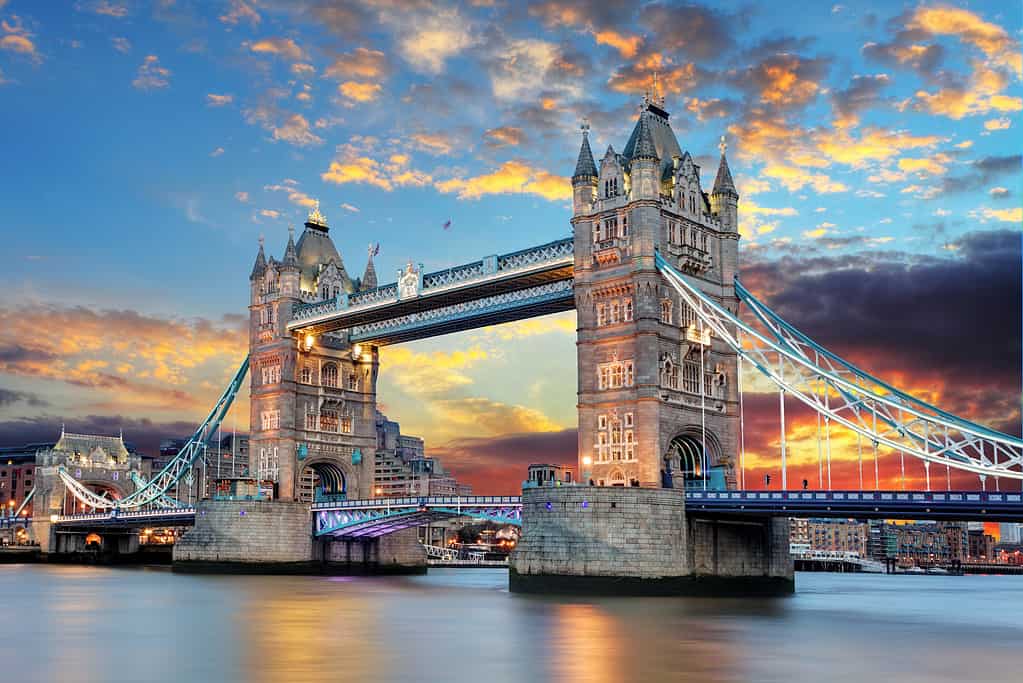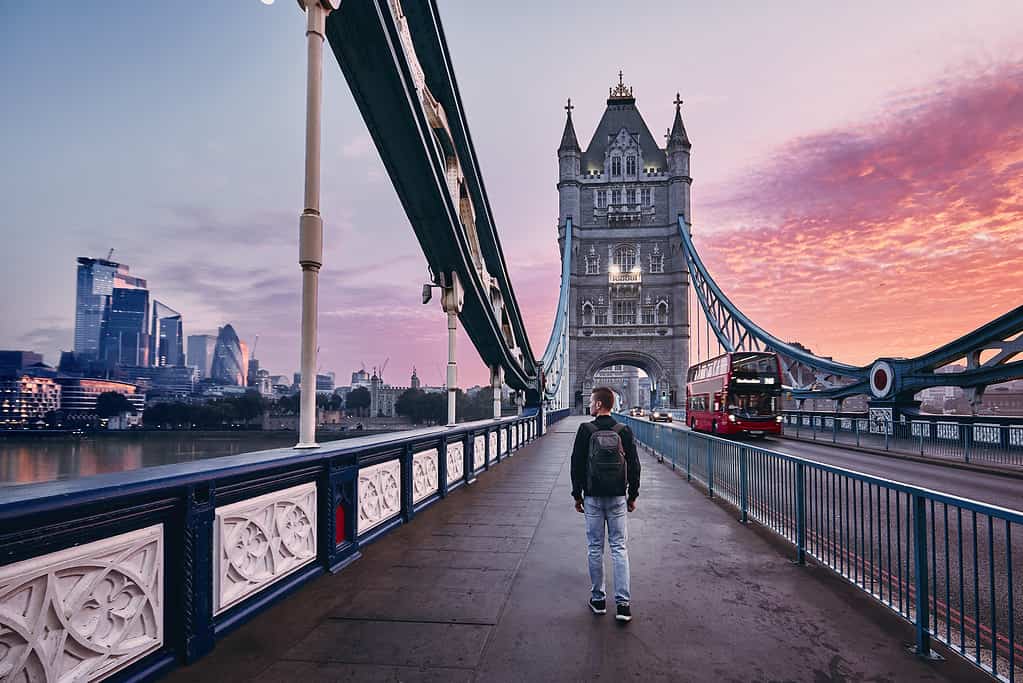God Save the King is playing in the background. The camera pans to Tower Bridge and zooms in closely. Many movies depicting London usually have Tower Bridge in a shot somehow. It is the quintessential London backdrop. When most people close their eyes and picture London, Tower Bridge or Big Ben are the two landmarks they always think of. But most people probably don’t know why or how Tower Bridge in London was built.
You’re in luck because you are going to find out all about Tower Bridge in London— the how, why, and where, and even a few fun facts along the way.
Why Was Tower Bridge Built?

Many people mistake Tower Bridge for London Bridge. There was a rumor that an American millionaire mistakenly bought London Bridge thinking it was Tower Bridge (but that’s been dispelled by many first-hand witnesses!).
©RockingStock/iStock via Getty Images
London was a metropolis and an important power player in Europe and beyond. In fact, London was the largest city in the world in 1815 and it tripled in size by 1860. By 1891, it had grown to about 5 million people. So with a city of millions in the mid-1870s, it’s quite a surprise that there weren’t enough bridges to connect the north and south sides of London, especially more eastward.
By 1876, the most easterly bridge was London Bridge. More than a million people lived in the east end of the city. The commute to cross the river sometimes took two hours. So, the government decided to build a new bridge. The government put together the Special Bridge or Subway Committee to navigate the decision-making of how the bridge will be built and the design of the said bridge.
How Was Tower Bridge Built?
The construction of Tower Bridge started in 1886 and took a whopping eight years to build. Sir John Wolfe Barry was there from beginning to end, overseeing the entire project. The funding came from the Bridge House Estates, the charitable trust that had funded and maintained London Bridge since 1282.
There were five contractors in charge of the construction and over 400 workers who reported to work every single day. Two concrete piers were sunk into the riverbed to support the construction and its foundation. The framework of the bridge — used for the towers and pathways — had more than 11,000 tons of steel. The construction workers then used Cornish granite and Portland stone to cover and protect the framework. The cover also gave the bridge a more appealing and prettier appearance.
The bascules that lifted the middle portions of the bridge were powered using steam hydraulics. Today, the bascules are still powered by hydraulics, however, instead of steam, oil and electricity are used.
The Bridge’s Design

In 1999, a man by the name of Jef Smith crossed Tower Bridge with two sheep.
©TomasSereda/iStock via Getty Images
In 1876, after London’s government decided it was time to build a new bridge, a committee was formed. For years, they debated what the bridge would look like. They launched a competition for designs and more than 50 designs entered the competition. The winning bid was picked in 1884, eight years later. The city’s architect, Horace Jones, acted as the designer of the bridge. Sir John Wolfe Barry was the engineer who oversaw the construction of Tower Bridge. The two men were the winners of the public competition.
The bridge was to be built with a Neo-Gothic design to match the Tower of London, which stood on the north side of the river. Queen Victoria requested the bridge’s congruence with the historical landmark, which is why the bridge has an older look than its actual age.
Tower Bridge in the Modern Era
Tower Bridge opened on June 30, 1894, with a ceremony that was hosted by the Prince and Princess of Wales (the future King Edward VII and Queen Alexandra). The pedestrian bridge was accompanied by high-level walkways so people could use the bridge when it was raised. Because stairs were needed to access the walkways, mainly pickpockets and prostitutes frequented the bridge, and thus the walkways were shut down.
During the World War II London air raids in 1940, Tower Bridge sustained damage from explosions and had to be restored. In 1982, Tower Bridge opened its exhibition, which still runs today as a tourist attraction.
Location of Tower Bridge

In an official US visit to the UK, President Bill Clinton’s motorcade was split in two as the bridge’s bascules opened to allow a sailing barge to pass.
©leonard78uk/iStock via Getty Images
Tower Bridge is located between the Borough of Tower Hamlets on the north and the Borough of Southwark on the south. The Tower of London is the nearest landmark to the north of the bridge. Its nearest tube stations are Tower Hill on the Circle and District lines, London Bridge on the Jubilee and Northern lines, as well as Bermondsey Station on the Jubilee line.
Foot and Auto Traffic
There was also a pedestrian bridge and high-level walkways along with an automobile bridge (at the time of opening, it allowed for horse-drawn carriages to go across). The increasing crime activity in the area prompted the city to close the walkways in 1910. However, in the early 1980s, as Tower Bridge was refitted with a glass floor for exhibition visits, the walkways also reopened.
Today, the Bridge remains a busy crossway between the north and south sides of London.
River Traffic
When the bridge officially opened, boats passed through quite often. But as pollution built up on the Thames River, the government passed stringent measures regarding which sea vessels would be allowed on the river. This means that boat traffic is much lower than before. A boat wishing to pass must notify the bridge’s staff at least 24 hours in advance. A publication of when the bridge will open is then posted on Tower Bridge’s website.
Fun Facts About Tower Bridge and its Surroundings

In December 1952, a double-decker bus jumped across the bridge as the bascules were going up. The bus driver noticed the road lifting and hit the gas to jump across (and he made it!)
©Chalabala/iStock via Getty Images
- A whopping 40,000 people cross the iconic bridge every day either by walking, driving, or bicycling.
- Although not a lot of sea vessels are allowed in the London portions of the Thames, Tower Bridge lifts about 800 times per year.
- Tower Bridge’s original color was brown.
- During the 2012 Summer Olympics held in London, the five Olympic rings were suspended from Tower Bridge.
- The Tower of London used to be a prison for several centuries, but now it houses the Crown Jewels.
- The London Borough of Tower Hamlets has historically been and still is one of the poorer neighborhoods in the city.
- The Borough of Southwark has the distinction of being home to several landmarks. It also has five bridges — Tower Bridge, London Bridge, Millennium Bridge, Blackfriars Bridge, and Southwark Bridge — connecting the north side of London to Southwark.
Conclusion
Tower Bridge is considered one of the most majestic bridges in Europe. Its architecture makes it one of the most recognizable bridges in the world. Built during the Victorian Era during the height of British world power, Tower Bridge represents that time when the British enjoyed being the most powerful entity in the world.
If you get the chance to visit London, Tower Bridge will be one of the first stops on your tour. Along with the Tower of London, which is directly next to the bridge on the north side, you can enjoy a half day’s worth of interesting historical activities. Oh, the things you’ll learn! Just make sure you capture those memories with pictures of the sights.
Thank you for reading! Have some feedback for us? Contact the AZ Animals editorial team.








